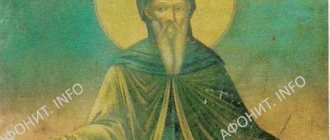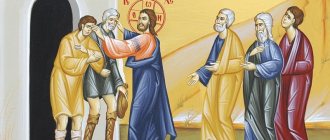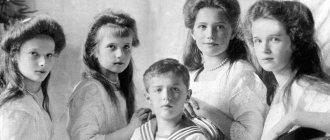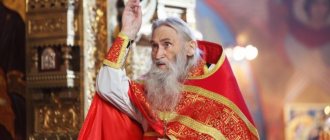| Klyuchevskaya Kazan Hermitage |
Klyuchevskaya men's hermitage in honor of the Kazan Icon of the Mother of God in the village of Turgenev,
Ardatov diocese
- Address: Russia, rep. Mordovia, Ardatovsky district, Turgenevo village, st. Shkolnaya, 20
- On the map: Yandex.Map, Google map (no exact coordinates)
It is located near the village of Turgenev and the village of Chetvertakova, which is part of it.
From the legend, confirmed by an ancient inscription recorded by the charter on a wooden board and stored in the Klyuchevskaya Church, it is clear that the Kazan Icon of the Mother of God appeared in a spring or spring near the village of Chetvertakova in 1707. The Mordovians who inhabited the outskirts of this village, who were at that time in paganism, seeing the miracles that were performed by the revealed icon, believed in the true God and received holy baptism.
Soon it was decided to establish a desert here. The location was convenient: the owner’s villages of Turgenevo and Chetvertakovo were located on the Saransk-Alatyr postal route, and the district capital of Ardatov was five miles away. Pustyn was created as a country courtyard of the Alatyr Holy Trinity Monastery, which, in turn, was assigned to the Trinity-Sergius Lavra. Already in 1708, on the key, by decree of the Trinity Monastery, the first wooden Kazan church was built. That same year, on August 29, the church was consecrated by the parish priest John.
In 1767, the dilapidated church was replaced with another, also wooden. The third temple, a stone one, was built in 1806 not at the source, but above it, on a hill. Alatyr Archimandrite Abraham, who founded this church, relied on local charity, on the parishes of Turgenev and Chetvertakov. The consecration of the summer part of the temple took place in 1807 with the blessing of Bishop Pavel (Zernov) of Kazan.
Pustyn soon became a center of pilgrimage and contributed to the Christian education of the peoples of the Volga region. In the first half of the 19th century, veneration of the revealed Kazan Icon of the Mother of God spread to neighboring counties. In 1848, during a cholera epidemic, the Alatyr people demanded that the abbot of the Holy Trinity Monastery move the image to the city, and Archimandrite Ezekiel complied. The icon went with a religious procession to Alatyr, it was carried with a religious procession around the entire city, soon after which the disease began to subside. In memory of this significant event, a procession of the cross was held in Alatyr every year on August 9, and a thanksgiving prayer service was held in Klyuchevskaya Hermitage. According to a special schedule, the icon, accompanied by monks and under police protection, was carried from home to home and sent on trips around the district.
During the 19th century, the desert buildings were rebuilt more than once. In the early 1840s, the quadrangle of the temple was supplemented with a refectory, almost doubling its area. At first, the temple had a wooden belfry with an 8-pound bell, and in the second half of the century a bell tower was built. The former wooden church above the spring turned into a chapel and was rebuilt twice.
At the end of the century, a monastic community gathered in the Kazan desert, which was recognized as a monastic brotherhood assigned to the Alatyr Holy Trinity Monastery. The flow of pilgrims to the spring was expanding - before the revolution, it used to be that the entire slope of the monastery hill was occupied by lying and sitting patients who were waiting in line to bathe in the healing spring.
In the 1930s, the hermitage was closed, the monks were expelled, and the wooden chapel and bell tower were destroyed. The Desert Temple was damaged, but survived. The flow of pilgrims and cure-seekers to these places did not stop during the Soviet years. By the end of the 1980s, the Kazan Church fell into disrepair: in many places the masonry was destroyed by leaks, the interior was deformed, the paintings were damaged, the dome was demolished, and the roof was half torn off.
With the establishment of the Saransk diocese, the question of reviving the Klyuchevskaya hermitage was raised. By a synodal decision of December 27-28, 1993, the monastery was reopened [1]. The temple was restored and decorated, a bell tower, two wooden buildings, a stone cell building with a house church were erected. Hotel rooms were created for pilgrims, whose numbers grew throughout the 1990s and 2000s. A wooden chapel with a bathhouse was erected above the source. On July 22, 2011, Patriarch Kirill of Moscow and All Rus' consecrated a new pilgrimage and educational center of the desert.
Statistics
- OK. ser. 2000s [2] - approx. 20 inhabitants
Klyuchevskaya Pustyn
Kazan Klyuchevskaya hermitage Monastery abbot Archimandrite Hilarion (Tsarev Ivan Dmitrievich)
Kazan Klyuchevskaya men's hermitage
Ardatovsky district, village. Turgenevo Turgenevskaya Kazan Klyuchevskaya (in honor of the icon of the Mother of God of Kazan) men's hermitage is located in the eastern part of Mordovia, Ardatovsky district, near the village of Turgenevo and the village of Chetvertakovo, which is part of it (hence its second name: Turgenevskaya). According to legend, the foundation of the desert was laid in the second floor. XVIII century on the occasion of the appearance in the source of the miraculous Kazan Icon of the Mother of God. Geographically, the place for the desert turned out to be very convenient: the Russian-owned villages of Turgenevo and Chetvertakovo were located on the Saransk-Alatyr postal route, the district capital of Ardatov was nearby, five versts away, another district center, Alatyr, was 18 versts away. From the moment of its foundation, the hermitage was thought of as a country courtyard of the Trinity-Sergius Lavra and the Alatyr Holy Trinity Monastery assigned to it. In 1708, the first wooden Kazan church was built on Klyucha. Having stood for 60 years, it became very dilapidated, so in 1767, with the blessing of Bishop Feofan of Nizhny Novgorod, it was replaced with another, also wooden.
The third temple, a stone one, was built in 1806 not at the source, but above it, on a hill. Alatyr Archimandrite Abraham, who founded this church, relied on local charity, on the parishes of the village. Turgenev and Chetvertakov, who considered the Key to be part of their spiritual world. The consecration of the summer part of the temple took place in 1807 with the blessing of Bishop Pavel of Kazan. In the early 1840s, the quadrangle of the temple was supplemented with a refectory, almost doubling its area. At the end of the 19th century. In the Kazan Hermitage, a monastic community gathered, which passed official registration and was recognized as a monastic brotherhood assigned to the Alatyr Holy Trinity Monastery. In the first half. XIX veneration of the revealed Kazan Icon of the Mother of God spread to neighboring counties. In 1848, during a cholera epidemic, the Alatyr people demanded that the abbot of the Holy Trinity Monastery move the image to the city, and Archimandrite Ezekiel submitted to public opinion. The icon went with the procession to Alatyr to stay there forever. The famous image was carried out with a religious procession around the entire city, and soon the disease began to subside. In memory of this significant event, a procession of the cross was held in Alatyr every year on August 9, and a thanksgiving prayer service was held in the Klyuchevskaya Hermitage. According to a special schedule, the icon, accompanied by monks and under police protection, was carried “to homes” and sent on trips around the district.
The former wooden church above the spring was turned into a chapel. In the 19th century it was rebuilt twice, and after the revolution it was destroyed by the Bolsheviks. Over the past few decades, the Kazan Church has fallen into disrepair: in many places the masonry was destroyed by leaks, the interior space was deformed, the paintings were damaged, the dome was demolished, the roof was half torn off. However, the veneration of the holy source continued in the era of vulgar atheism. With the establishment of the Saransk diocese, the question of reviving the Klyuchevskaya hermitage was raised: in 1993, a men's monastery was opened in Turgenev, which soon became widely known not only in Mordovia. The hermitage is headed by Archimandrite Hilarion. Today there are about 20 people laboring in the desert. The temple, famous for its splendor, was restored and decorated, a bell tower, two wooden buildings, a stone cell building with a house church were erected. There are hotel rooms for pilgrims, the number of which is constantly growing. A wooden chapel with a bathhouse was placed above the spring. Masses of pilgrims from all regions of Mordovia, Chuvashia, Ulyanovsk and Nizhny Novgorod regions come to Turgenevo for the holidays. Lit.: Alatyr Holy Trinity Monastery. – M., 1904 (the book was republished in 1997 by the brethren of the Turgenev Kazan hermitage of the Saransk diocese); Orthodox Russian monasteries. - M., 1912; Catalog of historical and cultural monuments of the Mordovian ASSR. – Saransk, 1979; Aristov N. Legends about local shrines // Ancient and new Russia, 1875, No. 6; Dobrokhotov Yu. Monastery walls of Russia // Capital S, 1996, September 13; Bakhmustov S. B. Monasteries of Mordovia. - Saransk, 2000; Monasteries: Encyclopedic reference book. - M.: Publishing house. Moscow Patriarchies - “Republic”, 2000.
A new pilgrimage and educational center with cozy cells and a refectory has opened in the oldest monastery of Mordovia. Every year thousands of believers come to the Kazan Klyuchevskaya Hermitage both from the republic itself and from other regions of Russia and the CIS countries. Now they will be able to devote more time to spiritual matters and worry less about such worldly things as temporary shelter and daily bread.
The new pilgrimage and educational center was opened by Patriarch Kirill of Moscow and All Rus', who made a pastoral trip to Mordovia. The ancient monastery where the center is located is located 150 kilometers from the capital of Mordovia - Saransk. The Primate, addressing the believers, called the Kazan Klyuchevskaya Hermitage a place of revival of true spirituality: “I am glad to see you all in this holy monastery, which just recently was in ruins. Few people could get here - there were not even roads. And today, against the backdrop of a marvelous landscape, we see a wonderful monastery - its buildings are visible many kilometers from here.”
The flow of pilgrims to these places never weakened - neither before the revolution, nor during the Soviet atheistic years. They came from all cities of Russia, Ukraine, Belarus and even far abroad. They settled right in the fields, lived in cars or tents - as best they could. The secret of the constant presence of pilgrims, among whom are not only Orthodox, but also representatives of other faiths and even atheists, is miraculous sources. They, as rumor claims, cure all ailments. It was in honor of them that the monastery once received its name.
Tradition says that in 1707, the Kazan Icon of the Mother of God was revealed in one of the springs that flowed among a wide Mordovian field. A few years later, a monastic monastery was founded here. Pustyn very soon became one of the largest spiritual centers and contributed to the long and complex process of Christianization of the peoples of the Volga region. Believers came to the revealed icon with worldly concerns, for consolation and protection from misfortunes, with requests for help for themselves and loved ones, for spiritual and physical healing. Before the revolution, it happened that the entire slope of the monastery hill was occupied by lying and sitting patients who were waiting in line to bathe in the healing spring.
After the revolution of 1917, the monastery was closed, the monks were expelled, and the churches were destroyed. The monastery found a second life in the mid-90s of the last century. During this time, the monks, no more than 20 in number, achieved the impossible. The monastery once again shone with golden domes, and its rich decoration - paintings, silver, mother-of-pearl - amazes the eyes of all who come. All this came about thanks to private donations. In a conversation with the monks, Patriarch Kirill not only appreciated the beauty of the monastery, but also gave instructions: “The beauty of every monastery and every temple is not only the walls, although the walls are of great importance, testifying to the feat of our ancestors, and sometimes, as in this case , - about the feat of our contemporaries. The most important beauty of the monastery is revealed in monastic life. And therefore, turning to you, dear monastic brothers: always be loving towards pilgrims, never push anyone away with an unreasonable word, excessive severity, or simply an insufficiently kind look. May your hearts always be open to meet people, and may thousands be drawn to you, because our people need spiritual support.” The patriarch's visit to the Kazan Klyuchevskaya monastery was the last point of his current journey through the Mordovian dioceses.
Literature
- Alatyrsky Holy Trinity Monastery
, M., 1904 (reprint. Klyuchevskaya Kazan Monastery, 1997). - Orthodox Russian monasteries
, M., 1912. - Catalog of historical and cultural monuments of the Mordovian ASSR
, Saransk, 1979. - Aristov, N., “Legends about local shrines,” Ancient and New Russia
, 1875, No. 6. - Dobrokhotov, Yu., “Monastery walls of Russia,” Capital S
, 1996, September 13. - Bakhmustov, S. B., Monasteries of Mordovia
, Saransk, 2000. - Monasteries: Encyclopedic reference book
, M.: Publishing house. Moscow Patriarchies - “Republic”, 2000.
inexhaustible source
See what an “inexhaustible source” is in other dictionaries:
- inexhaustible - • inexhaustible supply • inexhaustible interest • inexhaustible source • inexhaustible humor ... Dictionary of Russian Idioms
- INEXHAUSTABLE - INEXHAUSTABLE, inexhaustible, inexhaustible; inexhaustible, inexhaustible, inexhaustible (book). Inexhaustible, extremely abundant, not exhausted. An inexhaustible source. Inexhaustible riches. Inexhaustible wit. Ushakov's explanatory dictionary. D.N.... ...Ushakov's Explanatory Dictionary
- SOURCE - SOURCE, source, husband. 1. A stream of underground water (or other liquid) flowing to the surface of the earth; spring. Mineral spring. Oil source. 2. transfer, what. That from which something comes, arises, results; the original reason,... ... Ushakov's Explanatory Dictionary
- INEXHAUSTABLE is the source of Divine wisdom. Inexhaustibility of spiritual consolations. Dahl's Explanatory Dictionary. IN AND. Dahl. 1863 1866 ... Dahl's Explanatory Dictionary
- source - • powerful source • inexhaustible source • inexhaustible source • inexhaustible source • unlimited source ... Dictionary of Russian Idioms
- Inexhaustible (inexhaustible) source - Book. High Something that has great potential for use. Shishkov's extreme absent-mindedness, incredible forgetfulness and failure to recognize people... served as an inexhaustible source for various anecdotes (S. Aksakov. Memoirs). It seemed from the eyes... ...Phraseological Dictionary of the Russian Literary Language
- source - ▲ subject (of) from (what), which, act (about) source object, from which something comes; subject of emergence (# inspiration. rich #. inexhaustible #). transmitter. receiver. Exodus. exit. entrance. spring. hearth (# civilization. #… … Ideographic Dictionary of the Russian Language
- inexhaustible - inexhaustible, inexhaustible, inexhaustible, inexhaustible, inexhaustible, inexhaustible, inexhaustible, inexhaustible, inexhaustible, inexhaustible, inexhaustible, inexhaustible, inexhaustible, inexhaustible, inexhaustible, inexhaustible, inexhaustible,... ... Forms of words
- inexhaustible - aya, oh; kay, ah, oh. Book 1. One that does not dry out, in which water, moisture, etc. do not decrease. N. spring, source. Nth well. 2. Inexhaustible, inexhaustible; abundant. New wealth. New energy, love, hate. Your kindness... ... Encyclopedic Dictionary
- inexhaustible - aya, oh; ka/em, a, o., book. see also inexhaustible 1) One that does not dry out, in which water, moisture, etc. does not decrease. An inexhaustible spring, source. Nth well. 2) Inexhaustible, inexhaustible; abundant. New wealth... Dictionary of many expressions
AN UNEXHAUSTABLE SOURCE
The Kazan Klyuchevskaya men's hermitage got its name from the springs gushing out of the ground among the wide Mordovian field. In 1707, an icon appeared in one of the springs, now called the Kazan Klyuchevskaya Icon of the Mother of God, and soon a monastic monastery was founded next to the spring. Pustyn is located in the Saransk diocese, far from populated areas and main roads. But despite such remoteness, the flow of people to it, like a water flow of springs, never dried up... The Kazan Klyuchevskaya men's hermitage got its name from the springs gushing out of the ground among the wide Mordovian field. In 1707, an icon appeared in one of the springs, now called the Kazan Klyuchevskaya Icon of the Mother of God, and soon a monastic monastery was founded next to the spring. Pustyn is located in the Saransk diocese, far from populated areas and main roads. But despite such remoteness, the flow of people to it, like a water flow of springs, never dried up...
In 1993, with the blessing of Archbishop Barsanuphius of Saransk and Mordovia, Hieromonk Hilarion (Tsarev), a resident of the Nativity of the Virgin Mary Sanaksar Monastery, went to Klyuchi to lead the work of restoring the holy place, which had fallen into disrepair over the “godless decades.” The condition of the Church of the Kazan Mother of God amazed Father Hilarion: “In the church... there were no windows, no doors, no floors, no roof, and the walls could barely hold up, had a deplorable appearance, as if under shelling and bombing; the brick was weathering, and the birds were building nests, and quinoa was growing above.”* It is not easy for pilgrims who have come to the desert today to believe that once a picturesque temple on the hillside was practically a pile of stones... Through the prayers and ascetic labors of Father Hilarion (now an archimandrite and governor of the monastery), the brethren and lay associates managed to return the monastery has an appearance worthy of the holiness of this place. However, it cannot be said that the work of restoring the desert is completed - the number of people striving to visit the monastery, swim in the holy spring water, and venerate the icon of the Mother of God is growing every year; on major holidays, pilgrims sometimes have to be accommodated directly in the church... Currently, on the territory of the monastery there is construction of a temple in the name of St. Sergius of Radonezh, a large fraternal building and a refectory. Of course, such a significant undertaking requires the investment of a lot of effort and money. But Archimandrite Hilarion and the brethren of the monastery believe that the flow of human help from the desert will not dry up, despite all the economic crises, because those who visit the monastery at least once forever understand what is truly valuable in the world.
* Quoted from the book: Gerasimov A.I. Kazanskaya Klyuchevskaya hermitage. Saransk, 2003. - Ed.
KLYUCHEVSKY IN HONOR OF THE KAZAN ICON OF THE MOTHER OF GOD MONASTERY
Founded as a country courtyard or hermitage of the Alatyr monastery in the name of the Holy Trinity. Located near the village. Chetvertakov, next to the revered source (key), the place of the appearance of the locally revered Kazan Klyuchevskaya Icon of the Mother of God. In 1707-1708 By decree of the locum tenens of the Patriarchal Throne, Metropolitan. Stefan (Yavorsky) was built over the source and on August 29. 1708, the rector of the Chetvertakovo church of St. A wooden church was consecrated by John and the clergy. in honor of the Kazan Icon of the Mother of God. The construction was supervised by the abbots of the Alatyr Trinity Monastery Lev (Alexandrovsky) and Jonah (Shatilov). According to the inventory of 1764, the church “is twelve fathoms long, five fathoms wide, there is a porch near that church. That church is covered with planks, very dilapidated, and on the church there is a gilded iron cross. There are iron chains, there are three doors in the church with iron hooks and hinges, iron staples, the front doors have an internal lock”; antimins “printed on linen”, signed in 1701 by Metropolitan. Nizhny Novgorod and Alatyr Sylvester (Kholmsky) (cited from: Gerasimov. 2007. P. 12, 20).
In 1764, the Kazan Church with other buildings was assigned to the Alatyr Trinity Monastery as a country courtyard. There were 2 cell huts made of pine logs, a cellar, a bathhouse, and a barnyard; in 1769 lived the Alatyr hieromonks Jacob (Ivanov) and Job, mon. Abraham, sexton Misail. In 1767-1768 with the blessing of bishop. Nizhny Novgorod and Alatyr Feofan (Charnutsky) on the site of the dilapidated one was built and in June 1769 by Archimandrite. Varlaam (Mikhailov) consecrated a new wooden Kazan temple.
In 1806, not far from the spring, on a hill above the spring, the Alatyr archimandrite. Abraham (Soloviev) laid the stone foundation for the Kazan Church. Construction began according to the orders of the Emperor. Alexander I Pavlovich dated June 3, 1804 and September 11. 1806 and was carried out at the expense of M. F. Kikina († 1819), the widow of a second major who lived on an estate near Alatyr, I. P. Turgenev with his sons and other benefactors. The consecration of the temple took place on June 29, 1807, on the day of the celebration of the apostles Peter and Paul, with the blessing of Bishop. Kazan and Simbirsk Pavel (Zernov). The consecration coincided with the opening of the local Klyuchevskaya, or Chetvertakovskaya, fair; this event attracted many pilgrims. In the beginning. 40s XIX century a refectory was added to the quadrangle of the temple, and on the 2nd floor. 19th century - belfry (according to other sources, bell tower). In 1851, an iconostasis was installed, transferred from the Sergius Church of the Alatyr monastery. According to the inventory of 1856, the church (9 fathoms long, 5 fathoms wide, 12 fathoms high) had 23 windows, an iron roof painted with copper.
At the spring, on the site of the old Kazan Church. (1767-1768), there was a chapel with a bathhouse, rebuilt several times, a wooden cell building (1809). According to the statement of 1848, compiled by the Alatyr archimandrite. Ezekiel, the country yard was owned by 10 dessiatines. 816 sq. soot land, including 9 des. 2092 sq. soot garden and empty, 350 soot. “under different structures”, 75 soot. “under the church and chapel above the spring”, 480 fathoms. “under a country road”, 219 fathoms. "under the stream flowing from the spring." Since 1856, the farm had beehives.
July 12, 1911 Alatyr archimandrite. Nazariy (Andreev) made an inventory of both the Alatyr Trinity Monastery and the country yard, on the territory of which the Kazan Church was located, covered with iron (length 14 fathoms, 1 arshin, width 6 fathoms, height to the cornice 4 fathoms, above roof dome 51/2 fathoms), with 20 windows and 3 doors. Above the well there was a dilapidated wooden chapel with an iron roof (length 10 arshins, width 10 arshins, height 3 arshins) and 4 windows. Dr. “a wooden chapel, 3 arshins long, 3 arshins wide, 5 arshins high with a dome, 1 door, covered with iron, well preserved” (Ibid. p. 149). At the country house, a wooden fraternal building and 3 houses, as well as rows of fair stalls, were built. In 1913, during a fire, 2 houses burned down. 3 Dec. the same year, the Alatyr Monastery received insurance money for them in the amount of 1,488 rubles. 88 kopecks, with these funds the houses were restored. In May 1914, master I. Smyslov painted the roofs, floors and iconostasis of the Kazan Church.
The discovered Kazan Klyuchevskaya Icon was probably constantly in the Alatyr Trinity Monastery, and since 1768 only on holidays was it brought to the Kazan Church. July 23, 1823 Archbishop. Ambrose (Protasov) of Kazan and Simbirsk, with a special resolution, blessed the carrying of the icon in the Alatyr and Ardatov districts. In the spring of 1848, during a cholera epidemic in Simbirsk province, residents of Alatyr asked the rector of the Trinity Monastery, Archimandrite. Ezekiel performed a religious procession around the city with a miraculous image, after which the epidemic subsided. Since 1848, in memory of the deliverance of Alatyr from cholera, by order of the city mayor Novikov, annually on August 9. They made a religious procession around the city, and a thanksgiving prayer service was served in K. m. The shrine, accompanied by the brethren and under police protection, was carried “to houses” according to a special schedule approved by the Alatyr district police officer. The first religious procession was carried out, according to the decree of the Synod, on August 9. 1849 It was headed by Archbishop. Simbirsk and Syzran St. Feodoty (Ozerov).
The icon was decorated with a gilded copper frame, and since 1803 - a gilded silver frame, a chasuble with precious stones and a crown of red gold. In 1833, at the expense of the tradesman F. Ulanov, a new, carved gilded icon case was made. In 1858, according to the will of Archbishop. Simbirsk Theodotius (Ozerov) had an “emerald cross” attached to the image. According to the inventory of 1918, the icon was in the iconostasis of the Holy Trinity Cathedral of the Alatyr Monastery. The icon “measures 61/2 vershoks in height and 51/2 vershoks in width”, “overlaid with silver, gilded, weighing 10 pounds in the frame, sterling silver”; “This icon is an icon-painting, ancient scripture on a linden board, measuring 61/2 vershoks in height and 51/2 vershoks in width. The robe on this icon is silver, gilded, with a gold crown, weighing 1 pound 24 spools in the robe. The decoration of this robe consists of rhinestones and simple precious stones.” In the Trinity Monastery there was also a copy of the miraculous image “measuring 71/2 vershoks in length and 51/2 vershoks in width” (Ibid. pp. 154-155).







